Top News
September 25, 2014 Wu Li Jun of Ryukyu Shimpo
From October 29, Beijing Capital Airlines will start chartering two round-trip flights per week between Hangzhou and Naha. The new service will operate on Tuesday and Saturday using Airbus 320 aircraft, which has about 160 seats. The company plans to carry out regular service between the two cities by as early as 2015 if all goes smoothly.
Currently, there are three flight routes between Okinawa and the cities in mainland China, including two regular routes between Naha and Shanghai and Naha and Beijing, and one-charter route between Naha and Tianjin.
According to Tatsuo Kinjo, the director of Shanghai Office of the Okinawa Prefectural Industrial Promotion Corporation, Okinawa has received offers from Xiamen and Fuzhou in Fujian to start charter flights to Naha.
He said, “Many people will visit Okinawa from the provincial cities in China. The number of Chinese tourists to Okinawa is expected to increase in the future.”
(English translation by T&CT)
Go to Japanese
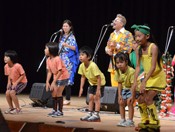
September 21, 2014 Ryukyu Shimpo
The Second Shimakutuba (Ryukyuan languages) Prefectural Convention titled “Connecting Okinawan Spirits Through Shimakutuba” was held, on September 20 at the Okinawa Convention Center in Ginowan City. According to the organizer, about 610 adults and children took part, enjoying Okinawan drama and comedy in Shimakutuba. They recommitted to revitalizing and promoting Okinawan languages.
“Gusuyo chuuganabira. Kurikara Shimakutuba kenmin taikai hajimi yabiin (Hello everyone, how are you? Let’s start the Shimakutuba Prefectural Convention),” said Shiyuu Kinjo, Uta Uema, Seita Yonaha, Ruka Miyahira from Oyama Kindergarten in a cheerful opening statement. They drew a big applause.
For the event, members of the Naha Cultural Association performed an Okinawan drama called Nusutto yamaa.
Okinawa Governor Hirokazu Nakaima sent a message, and Vice Governor Kurayoshi Takara read out the following statement; “I would like all Okinawan people to work together to promote and pass down our important languages.”
(English translation by T&CT and Megumi Chibana)
Go to Japanese
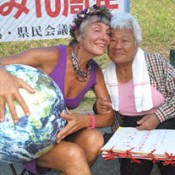
September 23, 2014 Ryukyu Shimpo
Oceanographer Katherine Muzik, who is researching coral reefs all around the world, visited the protest tent located in front of the gate of Camp Schwab in the Henoko district of Nago on September 22. Sit-in members protesting against the building of a new base, which would replace U.S. Marine Corps Air Station Futenma, were gathered at the tent. Muzik said that Oura Bay was a world treasure, having the richest coral reefs in the Pacific Ocean. She declared Okinawan people’s protest movement a success, pointing to the growth of support all around the world.
Muzik spoke in the endangered Okinawan language, Shimakutuba, about how the destruction of mountains would lead to the destruction of the sea, and the destruction of the sea would lead to the destruction of Okinawa.
While living in Okinawa for 11 years in the 1980s and 2000s, Muzik called for the protection of the coral reefs at Shiraho in Ishigaki Island where the Okinawa Prefectural Government had planned to build a new airport. This February, she wrote a letter to U.S. Ambassador Japan Caroline Kennedy, inviting the ambassador to dive with her in Oura Bay. Muzik was invited to visit Okinawa to take part in a symposium which was held in Nago on September 26.
Muzik, formerly a professor at Harvard University, has surveyed coral reefs in more than 30 locations around the world. She stressed that coral reefs were becoming extinct in various areas all over the world such as the Caribbean Sea, due to rising global temperatures, water pollution by red soil erosion and acidification. She added that she could not believe the U.S. and Japanese governments were intentionally destroying coral reefs for the sake of building the new military base.
Muzik said Oura Bay was a complete ecosystem, connecting smaller ecosystems in mountains, rivers and mangroves. She suggested that building an ocean reserve rather than the military base would contribute to employment and education.
According to Muzik, Okinawan people are faced with a choice between destruction and harmony. Like Scotland, she said, Okinawa’s democracy is taking root.
(English translation by T&CT)
Go to Japanese

September 23, 2014 Ryukyu Shimpo
September 23 is Autumnal Equinox Day, one of the 24 seasons in the solar year. It is the equinoctial day of autumn, when day and night are of similar length.
As autumn approaches, the night will become longer than the day.
Recent weather and climate conditions have been unusual for this time of year.
A flurry of wind and rain made a brief visit to Okinawa due to Typhoon Fung-Wong on September 22. Meanwhile, yellow Japanese persimmons grew in clusters in the gardens of homes in the Shuri district of Naha. The fruits attracted people passing by.
A Shuri resident Kazuki Gushiken, 10, said, “I did not think persimmons grew in such a place.”
Nine-year-old Homare Higa said, “I like persimmon, but I like grape too.”
(English translation by T&CT)
Go to Japanese

September 26, 2014 Ryukyu Shimpo
On September 25, 25 scholars, journalists and Okinawa-based peace advocates announced an emergency statement seeking cancellation of construction of a new base in Henoko, Nago. This base would replace U.S. Marine Corps Air Station Futenma in Ginowan City. They sent the statement to President Obama and Prime Minister Shinzo Abe. The statement also asks the governments of Japan and the United States to immediately close the Futenma base without conditions, such as moving the base within Okinawa.
Masaaki Gabe, a professor at the University of the Ryukyus, Seigen Miyasato, a political scholar and advisor of the Okinawa External Affairs Study Group, Moriteru Arasaki, former president of Okinawa University and Akiko Yui, former editor in chief of the Okinawa Times, held a press conference at the Okinawa Prefectural Government Office on the same day. They announced the statement, highlighting its key points such as; “the construction of a new US Marine Corps Air Station in Henoko will lock Okinawa into being a permanent, major US military base in the future.” They suggested that the disproportionate concentration of the US military bases in Okinawa is against the Charter of the United Nations.
Gabe said, “We would like many people to read the statement and think about the problems caused by the construction of the military base.”
Arasaki said, “We want the younger generations to know more about the base construction in Henoko.” They plan to create teaching materials for people to gain basic knowledge on the issue.
The Okinawa External Affairs Study Group will hold a symposium on the issue of the construction of a new US base in Henoko at the Okinawa International University at 2 p.m. on October 18.
(English translation by T&CT)
Go to Japanese
————————————————————————————
Emergency statement calling for an end to forcible surveys for the construction of the US military airfield in Henoko and the cancellation of the relocation plan.
The statement published by scholars and peace advocates in Okinawa follows:
To:
President Barack Obama
Prime Minister Shinzo Abe
U.S. ambassador to Japan Caroline Kennedy
Immediately stop forced surveys towards the construction of the United States Marine Corps air base in Henoko and scrap the plan to build a replacement facility for the Futenma base
September 25, 2014
We cannot accept the construction of a new US Marine Corps Air Station in Henoko that will lock Okinawa into being a permanent, major US military base in the future.
The residents of Okinawa should be treated as fairly as those who live in the mainland of Japan and the United States.
Nevertheless, the Governments of Japan and the United States have forced sacrifice on and discriminated against the Okinawan people for many years. Even now, the governments are still oppressing the people’s resistance, showing an authoritarian attitude towards opposition to the disproportionate concentration of the US military bases in Okinawa. Such action by these democratic governments is against the spirit of the Declaration of Independence of the United States and the Constitution of Japan.
Their action goes against the Charter of the United Nations, in which the signatories of the United Nations acted to save succeeding generations from the scourge of war, to reaffirm faith in fundamental human rights, in the dignity and worth of the human person.
The landfill project in Henoko is a grave error because it undermines democracy, and it will destroy the main habitat of an endangered species, the dugong. The United States will lose credibility with the international community, if it joins Japan in wiping out the dugong and drastically compromising the biodiverse environment of Yambaru (the northern part of Okinawa) in order to build a new air base.
Drumming up public fear, the Japanese government has used the dispute with China over the sovereignty of the Senkaku Islands, to justify permanently fixing the US Marine presence in Okinawa and increasing their access to the land and sea. It has argued the new base will play a role in deterring China, and that the MV-22 Osprey aircraft will help defend the islands. However, these assertions are unsubstantiated in both military and diplomatic terms. Since the end of World War Two, the United States government has consistently taken a neutral stance on sovereignty over the Senkaku Islands. Under pressure to reduce the national defence budget, the US military intends to gain funding from the Japanese government in its plan to transfer Marines from Okinawa to Guam, arguing the US marines play a role in defending the Senkaku Islands.
The presence of the US Marines on Okinawa is not deterrence. The effectiveness of the deterrence effect of the US forces depends on the willingness of the United States to defend Japan, and on US air and sea capabilities – not the marine force. The deterrence effect also depends on how the leaders and people of the nations at which deterrence is targeted evaluate the presence of the US Marines on Okinawa.
In extreme situations such as an armed conflict between Japan and China on or near the Senkaku Islands, Japan must have first responsibility for defense of the region, and then the United States will employ its sea and air power to support Japan. There is no benefit in the United States military sending the US Marines to the islands. If an armed conflict should happen in the region, this will only serve to catastrophically damage the economy and safety of the world, not only affecting Japan, China and the United States. The three countries should at least build a consultation mechanism to avoid unexpected armed conflicts. First, Japan and China should strive to reduce the growing distrust and conflict between the two countries. We would like the leaders of the two countries and Taiwan, to make diplomatic efforts to create peace in the East China Sea.
US Air Force Base Kadena and its ammunition depot have 1.7 times of the total area of the six major US bases in the main islands of Japan including Yokota, Atsugi, Misawa, Yokosuka, Sasebo and Iwakuni. Furthermore, the US Marine Corps Bases including Futenma Air Station in Okinawa occupy an area more than three times that of the Kadena Air Base. The excessive concentration of the US bases in Okinawa is an unbearable burden for Japan’s 44th smallest prefecture. People living in Okinawa would finally feel that the base burden has been reduced somewhat, if the marines were to withdraw from Okinawa.
We demand that the governments of Japan and the United States take the following measures:
1) Immediately stop survey works for the plan to build a new air base for the United States Marine Corps in Henoko in Nago, and abandon the relocation plan.
2) Immediately close the US Marine Corps Air Station Futenma and return its land to the landowners without the condition of relocating its facilities inside Okinawa.
3) We urge the Japanese government to; work on protection measures for rare species and the natural environment of the northern areas of Okinawa, including Henoko, Oura Bay and Takae; and apply for the inclusion of the Amami and Ryukyu islands on UNESCO’s provisional list of candidates for World Heritage sites. We would like the governments of Japan and the United States to listen to the recommendations on protecting endangered species in the areas of Henoko, Oura Bay and Takae, made repeatedly by the International Union for Conservation of Nature (IUCN).
On behalf of the advocates.
Seigen Miyasto
Moriteru Arasaki
Masaaki Gabe
The advocates:
Nariyuki AGARIE Osamu ARAKAKI Kiyoko OHSHIRO Tatsuhiro OHSHIRO Akihiko KATO Kunitoshi SAKURAI Manabu SATO SuzuyoTAKAZATO Tomokazu TAKAMINE Hiroshi NAKACHI
Tatsuhiro HIGA Mikio HIGA Eiichi HOSHINO Taizan MAEZATO Takeshi MIKI Akiya MIYAZATO Kimiko MIYAGI Hiroshi MIYATA Tateki YAFUSO Masako YAFUSO TomohiroYARA Akiko YUI
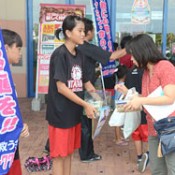
September 24, 2014 Ryukyu Shimpo
On September 23, supporters of a child who suffers from cardiomyopathy, launched a fundraising campaign at Carnival Park Mihama and Ion Store in Chatan. The first-grade student of Kuwae Junior High School Rai Matsushima could be saved by heart transplant surgery in the United States.
In addition to the members of the group, students from elementary and junior high schools in Chatan also took part in the campaign. Holding banners and placards, they called for donations. It will cost 215 million yen for the surgery, including travel fees. The group is accepting donations at each bank in Okinawa until November 30. For more information call the Raikun-sukuu-kai Office 098 (989) 7798. Homepage http://rai-aid.com
(English translation by T&CT)
Go to Japanese
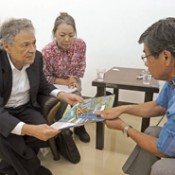
September 18, 2014 Ryukyu Shimpo
On September 17, Morton Halperin, who was the chief US negotiator during the negotiations for Okinawa’s reversion to Japan in the early 1970s, had a meeting with Nago mayor Susumu Inamine at the Ryukyu Shimpo Izumisaki Building in Naha. Halperin shared his views on the problems surrounding the relocation of the U.S. Marine Corps Futenma Air Station to Henoko, Nago. He said that a democratic government should not act against the will of the people.
During the discussion, Mayor Inamine explained that Okinawa only made up 0.6 percent of Japan’s total land area, but had about 74 percent of the American military bases in Japan. He said that he had won his second run for mayor after promising that he “will not allow new bases to be built over sea or on land.” Inamine stressed that “the opposition towards relocation to Henoko is undoubtedly the will of the citizens of Nago.”
Halperin expressed empathy with Mayor Inamine regarding the Futenma relocation problem. He insisted the U.S. government speak with the Japanese government, and arrive at a solution that reflects the voices of the local citizens just like when Okinawa was reverted to Japan. A deal was reached after negotiators listened to the people of Okinawa who wanted the prefecture returned to Japan. Likewise, leaders must once again listen to the will of Okinawan people.
In response to distress over the fact that there are still many bases 42 years after the return, Halperin said that he too is amazed that so many bases remain today.
Mayor Inamine talked about the American responses he heard on his recent visit to the United States. They also discussed the current situation of the Okinawa gubernatorial election which is likely to be held in November.
(English translation by T&CT and Lima Tokumori)
Go to Japanese
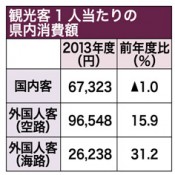
September 20, 2014 Ryukyu Shimpo
The Okinawa Prefectural Government announced a 12.1 percent increase in tourism revenue from the 2012 fiscal year to the 2013 fiscal year. At 447,868,000,000 yen, the 2013 figure represents a new high. This is the first time the number has increased by more than 10 percent since statistics started being recorded in the 2006 fiscal year. Average expenses per person were up by 0.9 percent to 68,062 yen. This was the first expenses increase in three years.
The average length of stay for tourists increased by 0.08 days to 3.38 days and expenses on services such as fine-dining increased among foreign tourists. These factors contributed to the new high in tourism revenue.
Among foreign tourists, the average expenses per person for those visiting Okinawa by air increased by 15.9 percent to 96,548 yen. The average expenses per person for those visiting Okinawa by sea increased by 31.2 percent to 26,238 yen. All the figures relating to expenses for foreign tourists such as lodging, traffic, and souvenirs were up from the previous year. Out of these numbers, fine-dining spending among foreign tourists visiting by air increased by 23.9 percent to 21,392 yen, while the number for those visiting by sea doubled to 2,581 yen.
The average expenses per person for domestic tourists decreased by 1.0 percent to 67,323 yen. Average expenses per person for domestic and foreign tourists increased in all categories from the previous year, except expenses for entertainment.
(English translation by T&CT)
Go to Japanese
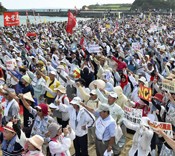
September 21, 2014 Ryukyu Shimpo
Citizen groups gathered on the beach in the Henoko district of Nago in Okinawa for a protest rally against the construction of a new offshore U.S. air base in Henoko to replace Marine Corps Air Station Futenma, on September 20. It was the second rally within a month. The first rally was held in front of Camp Schwab on August 23, attracting about 3,600 people. According to the organizer, about 5,500 people took part in the protest rally this time. Insisting they would not allow the U.S. and Japanese governments to build the new base, which they say threatens peace, the participants expressed their opposition against the plan to move the base inside Okinawa.
The executive committee consists of the “All Okinawa United Forum,” Okinawa Peace Movement Center, and an organization of opposition lawmakers elected from Okinawa, four fractions of opposition parties in the Okinawa Prefectural Assembly, and the Prefectural United Coalition, Peaceful Citizen Liaison Council, and Residents Council Against the Helipad Construction.
Representatives of each organization, Nago Mayor Susumu Inamine and Naha Mayor Takeshi Onaga, and a university student took the platform, asking the U.S. and Japanese governments to stop the construction.
They have adopted a resolution to call for Okinawan people to continue to work towards stopping construction of the new base.
Referring to the growth of the protest movement in and outside of Okinawa, Inamine said, “Okinawan people all want to protect the beautiful sea. We need to prove our identity as Uchinanchu, by stopping the construction.”
Hiroji Yamashiro, the director of the Okinawa Peace Movement Center talked about newly scheduled marine boring investigations and security activities against citizens by the Japan Coast Guard. He proclaimed, “We will never let the governments carry out such a reckless construction. Okinawan people should be determined to stop the construction.”
According to the executive committee, 67 motor coaches full of protestors, arrived one after another in Henoko beach, after midday on September 20.
Family members, community members and co-workers took part in the rally. They applauded the speakers.
The executive committee plans to ask the prefectural government to reject an application filed by the Okinawa Defense Bureau requesting approval to modify the landfill method to be used for the construction of the air base in Henoko. They also plan to hold a protest rally surrounding the prefectural office building in the middle of October when the prefectural government will have completed reviewing the application.
(English translation by T&CT)
Go to Japanese
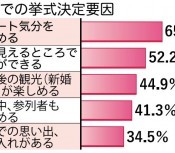
September 21, 2014 Ryukyu Shimpo
On September 18, the Okinawa General Bureau announced the results of a first-ever survey on Okinawa resort weddings. To the question, “Why did you have your wedding ceremony in Okinawa?” most respondents (65.8 percent) wanted to enjoy the resort feeling, followed by respondents who wanted to be able to have their wedding ceremony overlooking the sea (52. 2 percent ) and those who wanted to do honeymoon sightseeing after wedding (44.9 percent).
In terms of satisfaction with services, 61.1 percent of respondents were “very satisfied” and 33.3 percent were “somewhat satisfied”. However, there were some respondents who suggested “a lack of cooperation between the partner companies in the local and the main islands of Japan,” and expressed their dissatisfaction with travel from the airport to resort sites.
The Okinawa General Bureau carried out the online questionnaire survey from June 27 to 28. A total of 412 men and women who had resort weddings in Okinawa responded to the questionnaire.
The annual number of resort wedding ceremonies in Okinawa has increased by 54.6 times to 10,921 couples, from only 200 in 1999 when the Okinawa Prefectural Government began to record wedding visitation statistics. However, in the resort wedding business, Okinawa competes domestically with Karuizawa, Hokkaido, and Hawaii and Guam abroad. Some tourist business experts say that Okinawa can expect more competition for the resort wedding market in the future.
The Okinawa General Bureau suggested that local government and travel and service companies should aim to attract not only wedding couples but also customers who want to mark other stages of their lives such as a golden wedding or silver wedding anniversaries. The bureau officials stressed that building good relationships with customers would help maintain and develop Okinawa tourism.
(English translation by T&CT)
Go to Japanese

September 14, 2014 Ryota Shimabukuro of Ryukyu Shimpo reports from Washington D.C.
On September 9, an event introducing Okinawan literature titled “Living Spirit” was held at the US Library of Congress in Washington D.C. Katsunori Yamazato, literary scholar and president of Meio University, and Frank Stewart, a professor at University of Hawaii, were invited as lecturers. In addition to classic works such as The Omoro Soshi (a compilation of ancient poems and songs from Okinawa and the Amami Islands) and those written by Yushiya Chiruu and Unna Nabii, the lecturers also introduced post-war Okinawa works such as The Wild Boar That George Gunned Down by Eiki Matayoshi and The Paper Plane at the Empire State Building by Eikichi Nagado. They highlighted key historical and cultural influences on the literature, including; the Battle of Okinawa and the social situation including the US military base problem after the war, traditional customs and manners, and women’s key role in spiritual culture.
The event started with the introduction of prominent Okinawan literary works by Prof. Stewart who summarized them in English. Yamazato explained the social background to the works. Yamazato stressed that social situations have been inseparable from Okinawa literature. He highlighted the importance of a petition in 2013, in which Okinawan people requested the central government to cancel the MV-22 Osprey aircraft deployment to US Marine Corps Futenma Air Station and the plan to relocate the Futenma base within Okinawa. He reflected that Okinawan people’s united action in an ‘All-Okinawa’ bi-partisan resistance showed a maturing of Okinawa society.
“Local things such as Uchinaguchi (Okinawan dialect) and Okinawan culture were not treated well in the past, but Okinawan literary people and artists have come to use uchinaguchi more often recently,” Yamazato said. He also explained the movement to restore traditional culture and identities.
(English translation by T&CT)
Go to Japanese










 Webcam(Kokusai Street)
Webcam(Kokusai Street)


